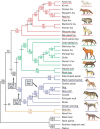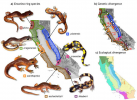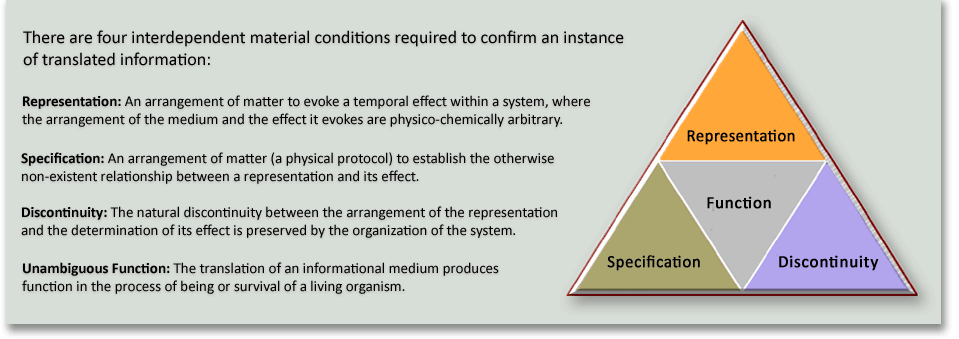AronRa
Administrator
Brilliant post. I wish I could give it a like or thumbs up.Again, I am not interested in spending the rest of my life breaking down the entirety of Otangelo's tirade of copy pasted responses. It's not worth my time really, I will again just point out a few things that caught my eye.
First: The mtDNA haplogroup tree, which I have talked about before on this forum.
Quick background. mtDNA is DNA inside the mitochondria, which is only inherited from the mother. Because of this, we can use this mtDNA to track human history back via the female line (mother to mother to mother, etc) by comparing the single nucleotide polymorphisms (or SNPs) between different individuals that define their "haplotype". From this, we can reconstruct a phylogenetic relationship where at each node a haplogroup is defined by SNPs that are held in common by the daughters of that node.
View attachment 130
[simplified visual explanation of haplogroups)
Now, the claim that Otangelo is making originated from Nathaniel Jeanson's book "Replacing Darwin" or one of his "articles" on answers in genesis. The claim being that the phylogenetic tree constructed from mtDNA haplogroups shows that everyone is descendant from three nodes, L M and N, representing the wives of Noah's sons (the green arrows in the figure shared by Otangelo).
Now, there are several problems with this, but the 3 main problem here are:
1: This is an unrooted tree. An unrooted tree shows that certain nodes have an ancestor/descended relationship of some kind, but you can't tell the direction of ancestry, i.e. you cannot say based on an unrooted three which node(s) is/are the ancestors of everyone else. You have to first determine the ROOT of the tree. This is where Jeanson goes wrong, he just says that the three nodes are the ancestors of every lineage, but he doesn't determine that the root is actually there. He just asserts it is there.
2. The second problem is that, it doesn't matter where you actually put the root on the tree, the tree shows that Jeanson is wrong about his claim about the three nodes that he points at as being "the three wives" are contemporary. His argument relies on the assumption that these nodes are contemporaneous, so they must be cousins of each other, not being an ancestor of another. But this is exactly what happens if you root the tree, and again, it doesn't matter where you put it. No matter what, you will either end up with one of the "wives" being the ancestor of the one or both of the other two, or you have one wive being the grandmother, and one the mother, and last one being the daughter. A very awkward family to say the least.
3. The easiest way to determine the root is by the "mid-point". The unrooted three does show the "distances" in terms of genetic difference between the nodes, so by making the reasonable assumption that all lineages experienced roughly the same number of genetic changes since they diverged from the common ancestor, we can place the root at the point where each descendant lineage is rouglhy the same distance away from the common ancestor.
View attachment 128
If you do that with the mtDNA haplogroup tree, you get the following. (see B)
View attachment 129
Not only is one (haplogroup L) of the so-called "three wives" the ancestor of the other two "wives" M and N (red arrows), note that these three nodes aren't even the ancestor of every lineage (those on the left). So these three nodes don't even represent the ancestors of everyone alive as well. And there are several published papers on this that shows a similar story. What is more, the L M and N nodes represent haplogroups that are distributed largely on different continents: L is more common in Africa while M and N are common in non-african continents. Since L is the ancestor of M and N, this supports the out of Africa scenario.
Jeanson still insists that the actual root lies closes to the "three nodes" denoted by these arrows. The problem here is that you no longer have the mid-point as the root. This makes some lineages extremely long compared to the others, in particularly the L haplogroups of Africa. This is why Jeanson has to assert that African people experienced MORE mutations, claiming that they have a higher mutation reproductive rate. He has no evidence to support this, it is just his way to try to squeeze the data as much as he can into his conclusion. It is nothing but ad hoc excuses.
Lastly, about the claim that this fits into a 6000 time scale, Jeanson uses this tree to calculate when the last common ancestor lived by using a mutation rate that is far too high. He messes this calculation up by measuring the mutation rates by comparing mothers to daughters, instead of using grandmothers, mothers and daughters. The problem here is that he includes somatic mutations in the mtDNA to calculate the mutation rate per generation, since only the mutations in the germline are inherited, so for that you need to compare the mtDNA from at least 3 generations to see how many mutations were actually inherited via the germline.
If you want to see more on this, read up on Ration alMind's review of Jeanson's book or watch Dan's (Creation Myths) video review on youtube.




